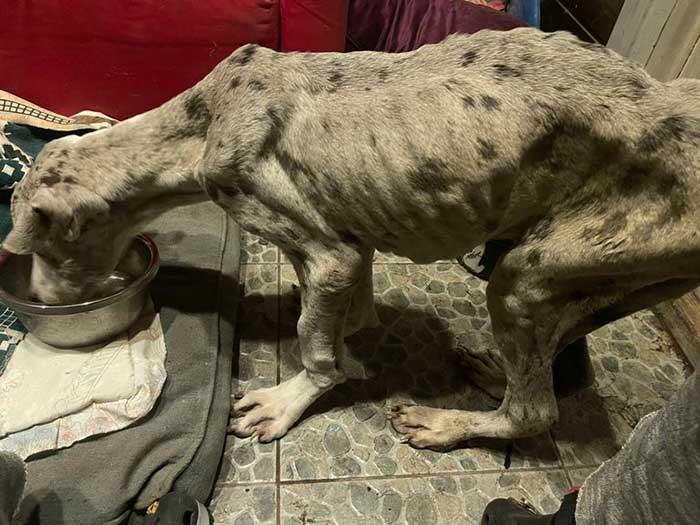The Silent Cry Among the Stones
In the quiet isolation of a quarry, surrounded by cold gray rocks and silence, a small puppy lay barely moving. Its frail body, marked by hunger and exhaustion, told a story words could not. For passersby, it might have been easy to miss—just another shape among the stones—but for one group of volunteers, it became a call to action.
When they approached, the puppy lifted its head weakly. Its eyes, though tired, seemed to hold a plea that needed no language. What they discovered soon after was both heartbreaking and extraordinary—a reminder of how the instinct to survive can push even the gentlest creatures to the edge of possibility.

Abandoned Among the Stones – A Story of Survival
The puppy, later named “Pebble” by rescuers, was found in a remote quarry area where few humans ever ventured. There was no food, no shelter, and barely any shade. It was clear that Pebble had been there for days, perhaps longer, surviving against all odds.
Volunteers from Furever Rescue Foster, a local animal organization, rushed to provide immediate care. What struck them most was Pebble’s fragile frame—ribs visible through the thin fur, yet its stomach appeared oddly bloated. Concern quickly turned to alarm.
At a nearby veterinary clinic, an ultrasound revealed the shocking truth: Pebble’s stomach and intestines were filled with small stones. The puppy, driven by starvation, had eaten rocks in a desperate attempt to ease the emptiness in its stomach.
Why Animals Eat Stones – The Science Behind “Pica”
What Pebble did might sound unbelievable, but this behavior has a scientific explanation. In veterinary medicine, it’s known as pica—the ingestion of non-nutritive substances such as dirt, cloth, or stones.
According to veterinarians, pica can arise from malnutrition, stress, isolation, or instinctive confusion. When a young animal experiences prolonged hunger, its brain sometimes triggers survival responses that override logic. The act of swallowing something, even inedible, can momentarily soothe hunger pangs.
In Pebble’s case, the stones provided a false sense of fullness, but they also caused internal blockages that could have been fatal. Similar cases have been reported not only in dogs but also in wild species like birds and even marine animals, often linked to scarcity of food or environmental stress.

The Rescue Effort – Compassion Meets Medical Precision
Veterinarians knew Pebble’s condition was serious. The ultrasound showed the stones had compacted in the intestines, preventing digestion. Without timely intervention, the situation could have worsened rapidly.
After careful evaluation, the veterinary team decided on a delicate surgical procedure to remove the stones. It was a risky decision given Pebble’s weakened state, but it offered the only real chance for recovery.
The operation took hours of precision and teamwork. Each removed stone was a reminder of the hardships this tiny creature had endured. When the final one was extracted, a quiet sense of relief filled the room. Pebble had made it through the most critical stage.
In the following days, the medical team closely monitored Pebble’s recovery. Gradually, the swelling reduced, appetite returned, and the puppy began to wag its tail—small signs of resilience that brought smiles to everyone involved.
The Cultural Lens – Dogs as Symbols of Loyalty and Endurance
Across cultures, dogs have long been seen as emblems of loyalty, courage, and perseverance. From ancient mythology to modern literature, their unwavering spirit often mirrors the best of human qualities.
In Japanese folklore, dogs symbolize protection and purity—guardians against misfortune. In Native American legends, they represent companionship and the bridge between humans and the natural world. Even in ancient Greek mythology, the dog Cerberus was said to guard the gates of the afterlife—not as a creature of fear, but as one fulfilling its sacred duty with loyalty.
Stories like Pebble’s remind us why dogs hold such a powerful place in cultural imagination. They endure, forgive, and trust again, even after enduring hardships that would break many spirits. In a world that often forgets the quiet strength of compassion, these stories serve as a gentle awakening.

The Psychological Connection – Why Humans Respond Deeply to Animal Rescue Stories
Why do tales like Pebble’s resonate so deeply? Psychology offers some clues. Studies show that stories involving animal suffering and recovery activate regions in the human brain linked to empathy and protective instincts.
Humans naturally respond to vulnerability—especially in creatures unable to speak or defend themselves. Seeing a helpless animal saved and nurtured triggers emotional relief, reinforcing our sense of purpose and moral connection to the living world.
Moreover, in an era dominated by screens and fleeting news, stories of rescue and recovery stand out as reminders of authentic goodness. They rekindle our belief in small acts of kindness and the profound impact they can have.
From Desperation to Hope – A Symbol of Renewal
After weeks of care, Pebble’s transformation was remarkable. The frail puppy that once lay among stones now stood on its paws, tail wagging freely. Its fur regained shine, and its eyes—once filled with uncertainty—reflected curiosity and trust.
Volunteers noted how Pebble seemed drawn to people, often curling up beside them as if sensing gratitude. The same creature that had once fought silently for survival now embodied hope.
Such transformations often become symbols within rescue communities. They remind rescuers and animal lovers alike that every life matters, and that even small interventions can reverse what once seemed impossible.

Beyond One Story – Lessons About Instinct and Compassion
Pebble’s experience opens a broader discussion about how instinct and environment shape behavior. While it’s easy to view such incidents as purely emotional, they also offer insight into animal cognition and adaptive strategies.
Behavioral scientists note that survival instincts can lead to both ingenious and harmful acts. In the wild, animals adapt by finding unconventional food sources during scarcity. For domestic animals like dogs, those instincts remain, even when their environment changes drastically.
Recognizing these instincts allows humans to better care for their companions. It encourages more empathetic and informed approaches to animal welfare—ensuring that creatures like Pebble never face hunger or fear again.
The Mythic Echo – Stones, Endurance, and Rebirth
Interestingly, the image of “stones” carries symbolic meaning across many cultures. In mythology, stones often represent endurance, patience, and transformation—the same qualities Pebble demonstrated.
In Celtic legend, stones were seen as witnesses of time, holding the memory of endurance through harsh seasons. Similarly, in Hindu tradition, the Earth element (Prithvi) represents stability and persistence.
Viewed through this lens, Pebble’s story becomes almost symbolic: a fragile being surrounded by stone, embodying endurance until kindness reshaped its destiny. What began as a tale of despair transformed into a metaphor for renewal—a reminder that even in lifeless places, compassion can take root.
The Role of Animal Rescue Organizations
Behind every recovery story are unseen heroes—volunteers, veterinarians, and donors who dedicate time and resources to saving lives. Organizations like Furever Rescue Foster not only rescue but also educate communities about responsible pet ownership, sterilization, and proper nutrition.
Such efforts are essential in addressing the root causes of abandonment. Awareness campaigns and adoption programs bridge the gap between compassion and action, ensuring that fewer animals suffer in silence.
In recent years, animal rescue initiatives have also gained digital momentum. Social media now amplifies stories like Pebble’s, transforming them from local rescues into global messages of empathy. Each share, each donation, each adoption adds a layer of hope to a world still learning to balance progress with kindness.

The Science of Healing – How Love Complements Medicine
While modern veterinary science can repair the body, emotional recovery often depends on human connection. Research from the American Veterinary Medical Association (AVMA) highlights how interaction with caregivers helps rehabilitate traumatized animals by reducing cortisol levels and restoring trust.
Pebble’s gentle response to human touch was part of this process. Care, consistency, and affection became as crucial as medicine. Science confirms what compassion already knows—healing is not just physical, but deeply emotional.
Conclusion: A Reflection on Human Curiosity and Compassion
Stories like Pebble’s resonate far beyond the world of animal rescue. They speak to something universal—the desire to understand, protect, and connect with the living world around us. Whether viewed through the lens of mythology, psychology, or biology, they all point to a single truth: empathy is a form of intelligence.
The puppy abandoned among stones reminds us that even the smallest life holds infinite value. It teaches that compassion, when acted upon, has the power to transform despair into hope. And perhaps that’s why we keep seeking such stories—not merely for comfort, but as a mirror reflecting the best parts of our humanity.
Sources
-
Furever Rescue Foster (Official Facebook & Case Reports)
-
American Veterinary Medical Association (AVMA) – Animal Behavior and Pica in Dogs
-
National Geographic – Why Animals Eat the Unthinkable: The Science of Pica
-
Smithsonian Magazine – Dogs in Myth and Culture: Loyalty Across Ages
-
Psychology Today – The Empathy Effect: Why Rescue Stories Move Us
-
SECBuzz.com – Animal Welfare and Human Compassion Series
